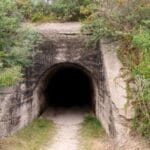As kids, we often dreamed of secret passages and hidden chambers lurking beneath our homes. While most of us outgrew those fantasies, the discovery of Derinkuyu, an entire city hidden beneath Cappadocia, Turkey, turns that dream into reality. This incredible find reveals a hidden world from a time long ago. Here are ten fascinating facts you probably didn’t know about the Lost City of Derinkuyu.
10. Discovered by Accident
Believe it or not, this ancient city wasn’t unearthed by archaeologists, but by a local man searching for his missing chickens! In 1963, during renovations, he noticed his chickens disappearing through cracks in his basement wall. He began excavating and stumbled upon a dark passageway leading to the city. This accidental discovery revealed the first of nearly 600 entrances found in homes, buildings, and caves in the area, all connected to the mysterious city.
9. More Than 2,000 Years Old
Derinkuyu’s age is astounding. Construction began around the 7th-8th centuries BC by the Hittites, with the Phrygians expanding it into the city we know today. Over centuries, inhabitants expanded the caves, adding rooms, chapels, and chambers to meet their needs. Unlike other ancient cities that have crumbled over time, Derinkuyu remains remarkably intact. Pompei, founded around the same time, couldn’t survive a volcanic eruption, highlighting Derinkuyu’s incredible resilience.
8. Hiding Place
While some chambers may have been used for storage, Derinkuyu primarily served as a refuge. During the 2nd century, early Christians, often also Jews, sought shelter in hidden underground spaces to practice their faith away from Roman persecution. The city provided a safe haven tucked away beneath the earth. It experienced a population boom during the Islamic raids of the 7th century as people sought to avoid imprisonment or worse.
7. Similar Cities
Derinkuyu isn’t alone. Cappadocia’s unique geology, with its easily workable rock and lack of groundwater, makes it ideal for underground construction. Over 40 underground cities have been discovered in the region, potentially connected by a vast tunnel network. Kaymakli, another similar city, offers a glimpse into this subterranean world, though with narrower passages and smaller rooms, creating a more claustrophobic experience.
6. Largest of the Underground Cities
Despite the presence of other underground cities, Derinkuyu stands out as the largest, both in size and population. It once housed 20,000 people and descends 18 stories (85 meters) deep, deeper than any other complex in the region. The multi-level city incorporated stables, churches, housing, and storage for essential supplies like food and wine and even had a dungeon.
5. The City Was Secure
Beyond its hidden location, Derinkuyu was designed for defense. Large stone wheels could be rolled in front of major entrances, creating thick, impenetrable barriers. Narrow tunnels forced attackers to proceed single file, making them vulnerable. The city’s design transformed potentially overwhelming forces into manageable threats, ensuring the safety of its inhabitants.
4. Ventilation Shafts and Water Wells
Survival in an underground city requires reliable access to fresh water and air. Derinkuyu featured over 15,000 ventilation shafts, about 10 centimeters wide, that provided fresh air down to the city’s lower levels. These ingeniously designed shafts ensured sufficient ventilation. Some shafts doubled as wells, providing water. Ironically, unaware surface dwellers sometimes used these vents as water sources, oblivious to the city beneath their feet.
3. Barrel-Vaulted Ceiling
Located on the second floor, Derinkuyu’s barrel-vaulted ceilings distinguish it from other underground cities. These decorative ceilings, typically used in Byzantine missionary schools, soften the edges of rooms and create the illusion of space. These high-ceilinged rooms, accompanied by adjacent study rooms, were used for religious schools, reflecting the city’s role as a sanctuary during times of religious persecution.
2. Abandoned
The Greco-Turkish War (1919–1922) led to a population exchange in 1923, aiming to create more ethnically homogenous populations. The Cappadocian Greeks, who then inhabited Derinkuyu, left, taking with them the secret knowledge of the underground city. The city was left silent, with only hints of its past existence remaining in the tunnels.
1. Not the Biggest
The exploration of Cappadocia’s underground is far from over. In 2013, archaeologists discovered another city in Nevsehir, potentially larger than Derinkuyu. This city, found during a housing project demolition, might reach depths of 370 feet (113 meters). Surveys suggest that the new city might be a third larger than Derinkuyu, featuring multilevel sanctuaries, kitchens, oil presses, air shafts, and a winery. Perhaps more hidden cities are waiting to be discovered!
Derinkuyu, a testament to human ingenuity and resilience, continues to fascinate us with its secrets. From its accidental discovery to its intricate design, this underground city offers a unique window into the past, reminding us of our ancestors’ resourcefulness and determination in the face of adversity.
What do you think is the most fascinating aspect of Derinkuyu? Leave your thoughts in the comments below!










